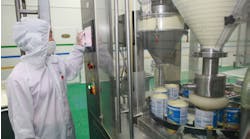There are several factors or mechanisms that affect a material’s tendency to cake and that will, over time, produce the kind of cohesion and strength that will create serious discharge problems in bins, hoppers and silos. Some materials are more susceptible to caking than others, but knowing the physical conditions that produce caking and the types of mechanisms associated with a given bulk solid, allows plant managers to make operational changes that will reduce these caking effects.
Caking mechanism: Chemical oxidation
Physical process: Oxidation rates increase with even slight to moderate increases in moisture. High temperatures also increase oxidation, and because the reaction is exothermic, oxidation accelerates once it starts.
Susceptible materials: Any material that contains carbon, coal, iron, aluminum and copper.
How to reduce: Keep the material dry and purge vessels with nitrogen or carbon dioxide. Avoid dead regions in the bin or hopper and empty the vessel periodically to eliminate long-term storage. Do not spray stored material with water to cool it immediately prior to or during storage.
Caking mechanism: Crystal growth
Physical process: Crystals form between particles in some low moisture, water-soluble materials that are exposed to temperature fluctuations.
Susceptible materials: Sugars, salts, acids and other water-soluble materials with these components.
How to reduce: Keep the material extremely dry, convey with dry air, and either promote interparticle motion during storage or increase moisture content to keep surfaces from drying out.
Caking mechanism: Drying
Physical process: Instantaneous cohesion can increase by multiple orders of magnitude with drying. Heat and exposure to dry air will exacerbate caking.
Susceptible materials: Materials with water-soluble components or solids with superfine components such as clay in limestone, coal or ore.
How to reduce: Eliminate drying by spraying the surface with water. Do not purge the vessel with dry air.
Caking mechanism: Elastic windup
Physical process: Springy solids can cause instantaneous cohesion problems. Heat or moisture can relax the windup but once the conditions are removed, the problems the windup returns and can be especially severe.
Susceptible materials: Materials that are in the form of flakes, strong or chips such as polymers, elastomers, wood chips and pulp, fiberglass, foamed polymers of chopped wire.
How to reduce: Reduce solids contact pressure with a proper vessel design that provides flow along the walls, eliminate temperature fluctuations and avoid impact loading of susceptible materials.
Caking mechanism: Oil deposits
Physical process: High temperatures can draw out the natural oils in particles. A decrease in temperature afterward can dry the material.
Susceptible materials: Materials containing natural oils such as soybean meal, or materials with oil added, such as cakes mixes.
How to reduce: Reduce storage temperatures, promote interparticle motion during storage and design vessels to promote flow at the walls to prevent hangups.
Caking mechanism: Solvents introduced from previous processing steps
Physical process: Temperature variations allow the solvent to permeate through to the particle surface where it dissolves the particles and forms a glue.
Susceptible materials: Adipic acid and other bulk solids derived from a slurry process and then dried.
How to reduce: Dry the material thoroughly and agitate the materials while cooling it. Prevent temperature excursions after processing until the solvent is completely dissipated.
Caking mechanism: Viscous deformation
Physical process: Temperature, contact pressure and time at rest in a storage vessel softens the material’s temperature.
Susceptible materials: Pitch, adhesives and elastomers that soften with temperature and contact pressure.
How to reduce: Decrease storage temperatures below the critical softening temperature, limit storage time, and regularly recirculate storage vessel material.
Caking mechanism: Water that is chemically bound within particles
Physical process: Some materials will hydrate with moisture from the atmosphere. If chemically bound water settles on the outside surface of the particles and the temperature drops, the water will combine with the material and can cement particles together.
Susceptible materials: Gypsum, limestone, Kernite and materials that have hydration temperatures close to room temperature.
How to reduce: Keep the material dry, convey it will dry air and do not place hot material in cold storage vessels. It’s also important to purge storage vessels with dry air or nitrogen and avoid temperature cycles that cross over hydration temperatures.
There is no guaranteed way to predict exactly how any one bulk solid will behave based on experience alone. Even research and development, process calculations and pilot plant studies may not prevent material handling problems. The only effective way to predict and avoid processing problems is by measuring the material’s flow properties at simulated plant conditions and using this data to design or recommend equipment. This means duplicating temperature, storage time, chemical reactions and solids contact pressures while taking into consideration the construction materials used in the process or storage vessel.

